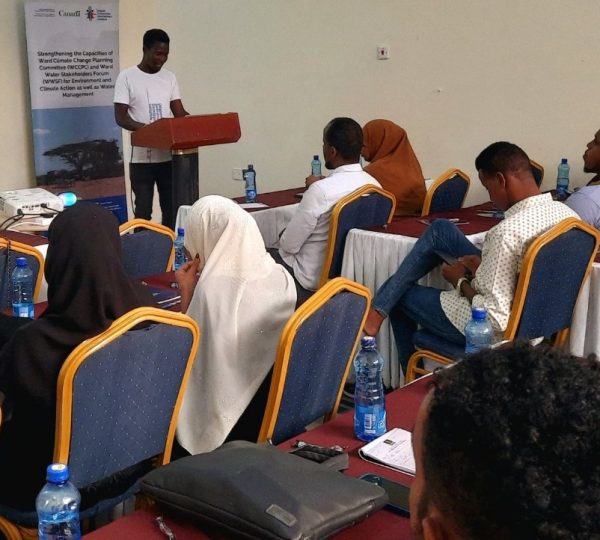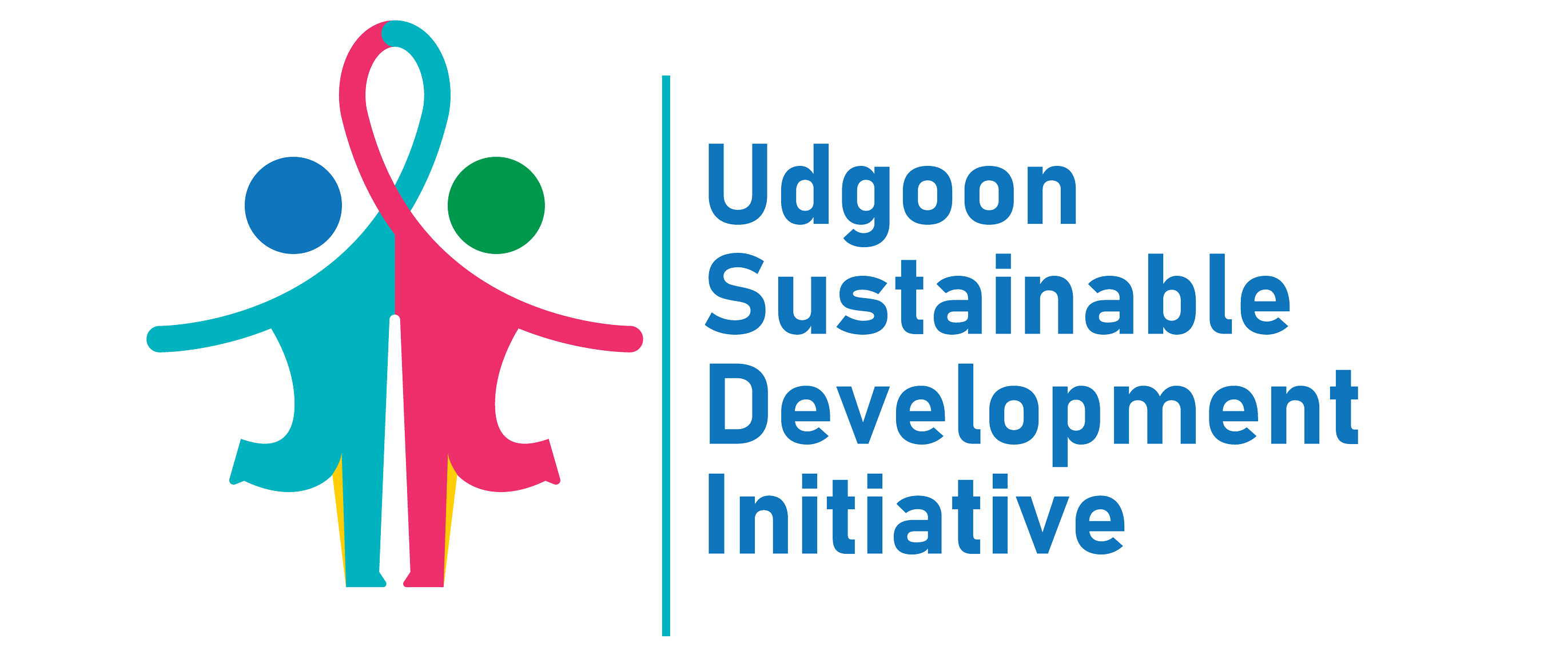Capacity Building Workshop on Climate Adaptation and Water Management
Date: 20th – 22nd November 2024
Location: Garissa Township Ward, Garissa County
Participants: 45 Ward Climate Change Planning Committee (WCCPC) members, Ward Water Stakeholders Forum (WWSF) members made of community elders, women leaders, youth, and marginalized groups
Organized By: Udgoon Sustainable Development Initiative (USDI)

Introduction
Garissa Township Ward faces recurring climate challenges, including droughts, floods, and water scarcity, which threaten livelihoods and exacerbate resource conflicts. Recognizing these challenges, USDI organized a workshop aimed at equipping local stakeholders with the knowledge and tools to address climate adaptation and water management challenges effectively.
The workshop sought to strengthen the capacity of community institutions like WCCPC and WWSF to lead localized interventions. It also provided a platform for diverse community voices to discuss and develop actionable strategies tailored to Garissa Township Ward’s unique needs.
Workshop Objectives
- Enhance participants’ understanding of climate change impacts and water management challenges in Garissa Township Ward.
- Equip local committees with practical skills to implement sustainable climate adaptation strategies.
- Foster collaboration and inclusivity by integrating gender and marginalized group perspectives.
Highlights of the Activity
- Climate Change Impacts and Vulnerability Assessment
Focused on understanding how climate change affects Garissa Township Ward. Participants engaged in mapping exercises that identified key vulnerabilities, such as:
- Increased frequency of droughts, leading to reduced water availability for households and agriculture.
- Seasonal flooding, which damages infrastructure and increases health risks due to water contamination.
- Rising temperatures, which negatively impact human health, livestock, and crop productivity.
Outcome: Participants developed a vulnerability map, highlighting priority areas for intervention.
- Understanding Local Climate and Water Laws
Reviewed the regulatory framework governing climate and water management in Garissa County. Key regulations discussed included the County Water Management Act and the Climate Change Act (Amendment) 2024.
Participants noted the following challenges:
- Limited awareness of these laws among community members.
- Insufficient facilitation for WCCPC and WWSF to perform their roles effectively.
Outcome: The session emphasized the importance of advocacy and capacity building to improve compliance and enforcement of these laws.
- Addressing Water Management Challenges
Identified water management issues, such as poor infrastructure, limited access to clean water, and over-extraction of groundwater. Discussions focused on practical solutions, including:
- Constructing water retention ponds to mitigate flooding and store water for dry seasons.
- Developing community-led water purification projects to address contamination issues.
- Encouraging equitable resource allocation through community-based management.
Outcome: Participants committed to initiating localized water management projects with USDI’s support.
- Integrating Gender and Marginalized Perspectives
Stressed the need for inclusivity in climate and water management initiatives. Discussions centered on:
- Addressing barriers that limit women’s participation in decision-making.
- Empowering marginalized groups through training and capacity building.
Outcome: Participants proposed the formation of women-led water committees and targeted support for vulnerable groups.
- Prioritizing Actionable Recommendations
Consolidated discussions into a set of actionable recommendations to address climate and water challenges. These included:
- Advocating for stronger policy enforcement.
- Investing in drought-resistant crops and sustainable agricultural practices.
- Upgrading water infrastructure to improve access and efficiency.
Challenges Identified
- Limited resources for local committees to implement their mandates effectively.
- Insufficient community awareness of existing regulations and sustainable practices.
- Competing priorities among stakeholders, which hinder collaborative efforts.
Next Steps:
- Follow-up capacity-building sessions to deepen understanding and skills.
- Establish monitoring frameworks to track the progress of implemented solutions.
- Strengthen partnerships with local and county-level authorities to ensure sustained support.
Priority Issues
Underlying Climate Issues in Garissa Township Ward
- Recurrent Droughts
Prolonged periods of dry weather have become increasingly frequent, affecting water availability, agricultural productivity, and livestock survival. Many households in Garissa Township Ward rely on seasonal rains, which are becoming more unpredictable due to climate change. - Floods
Seasonal floods, especially during heavy rains, often lead to infrastructure damage, displacement, and contamination of water sources. Poor drainage systems exacerbate these impacts, making floods a recurring challenge for residents. - Temperature Fluctuations
Daytime temperatures in Garissa Township Ward can exceed 38°C, affecting human health and productivity. These extreme temperatures also increase water evaporation, further straining limited water resources. - Reduced Agricultural Productivity
Changing weather patterns have reduced the productivity of traditional crops, leading to food insecurity. Many farmers are unable to adapt to these changes due to limited access to resources and knowledge. - Desertification
The loss of vegetation due to overgrazing, deforestation, and climate variability has accelerated desertification, reducing arable land and exacerbating food and water scarcity.
Underlying Water Management Issues in Garissa Township Ward
- Water Scarcity
Garissa Township Ward faces chronic water shortages due to low rainfall, limited infrastructure, and over-extraction of groundwater. This scarcity affects households, agriculture, and livestock. - Poor Water Infrastructure
Aging or inadequate infrastructure, such as boreholes and distribution systems, hinders reliable access to clean water. Many residents rely on unprotected water sources, which are often contaminated. - Poor Drainage Systems
Flooding during the rainy season is worsened by inadequate drainage, leading to stagnant water and health risks such as malaria and cholera outbreaks. - Health Impacts Due to Contaminated Water
The reliance on untreated water sources exposes residents to waterborne diseases. Children and vulnerable groups are particularly at risk. - Conflict Over Limited Resources
Competition for scarce water resources has led to tensions between communities and households, undermining social cohesion. - Over-Extraction of Water
Unsustainable extraction of groundwater is depleting aquifers, reducing long-term water availability for future generations.
Actionable Recommendations
To Address Climate Issues
- Recurrent Droughts
- Establish water retention ponds to capture and store rainwater for dry seasons.
- Promote the adoption of drought-resistant crops to sustain agricultural productivity.
- Floods
- Develop proper drainage systems to manage floodwater effectively.
- Strengthen flood early warning systems and community preparedness plans.
- Temperature Fluctuations
- Promote afforestation and reforestation to moderate local temperatures.
- Introduce heat-resistant crops and livestock breeds.
- Reduced Agricultural Productivity
- Train farmers on climate-smart agricultural practices, including drip irrigation.
- Provide access to agricultural inputs such as drought-resistant seeds and fertilizers.
- Desertification
- Implement large-scale tree-planting campaigns involving schools and community groups.
- Enforce regulations to prevent overgrazing and deforestation.
To Address Water Management Issues
- Water Scarcity
- Increase investment in water infrastructure, including boreholes and storage tanks.
- Encourage community-led initiatives to promote water conservation.
- Poor Water Infrastructure
- Upgrade and expand existing water supply systems to meet growing demand.
- Ensure regular maintenance of water facilities to prevent breakdowns.
- Poor Drainage Systems
- Construct drainage systems in flood-prone areas to manage runoff.
- Engage local engineers and community members in designing solutions.
- Health Impacts Due to Contaminated Water
- Develop community-led water purification projects.
- Conduct awareness campaigns on safe water practices and hygiene.
- Conflict Over Limited Resources
- Establish community-based water committees to mediate and resolve disputes.
- Promote equitable resource sharing among all stakeholders.
- Over-Extraction of Water
- Enforce regulations to limit over-extraction of groundwater.
- Encourage the use of alternative water sources, such as rainwater harvesting.
